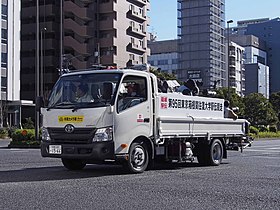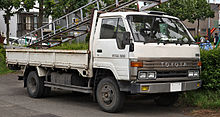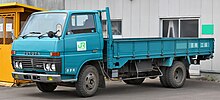Toyota Dyna
| Toyota Dyna | |
|---|---|
 | |
| Overview | |
| Manufacturer | |
| Also called |
|
| Production | 1959–present |
| Assembly |
|
| Body and chassis | |
| Class | Medium-duty truck |
| Body style |
|
| Layout | |
| Platform |
|
| Related | Toyota Coaster |
| Powertrain | |
| Transmission | |
TheToyota Dyna(Japanese:トヨタ・ダイナ) is a light to medium-dutycab overtruck for commercial use. In the Japanese market, the Dyna is sold alongside its twin called theToyoace.The Toyoace was a renaming of theToyopet SKB Truckas a result of a 1956 public competition with 200,000 entries.[7]"Dyna" is short for dynamic.[8]
The Dyna was originally available in Japan only atToyota Diesel Storelocations, then later available atToyota Storelocations, while the Toyoace twin was available atToyopet Storelocations. The Dyna was also sold as theDaihatsu Deltaand theHino Dutro.
In Japan, its traditional competitors are theIsuzu Elf,theMitsubishi Fuso Canterand theNissan Atlas.
The formerCentral Motorsproduced the Dyna Route Van from April 1957 to June 1967.[9]
History
[edit]
RK52
[edit]TheToyopet Route TruckRK52 was the contributing platform of the Dyna. A new Toyota Japanese dealership was established to sell the Toyopet Toyoace series SKB calledToyopet Store,which also introduced a sedan version of this platform called theToyopet Master.[10]
RK60 – RK80
[edit]Second generation ofToyopet Route Truck,Designed byKanto Auto Works,Ltd. The frame was shared with theToyopet Masterline RK23pickup truckand theToyota Stout.
TheToyopet Route Truckwas renamed as theToyota Dynain April 1959. Although it shared the same platform as the Toyoace, its appearance is more similar to its other derivative, theDaihatsu Delta.The K20 Series Toyoace was produced until the Y10 Series arrived. It was sold asToyota PK25 Truckfor the export market.[11][12]
K170 (1963–1968)
[edit]The originalsemi-cabover Dyna was replaced by the new model K170 series in September 1963, with a leaner design with quadruple headlights. The Dyna RK170 also provided the basis for the RK170B Toyota Light Bus, and was built on the chassis of theStout.It also had the Stout's 1.9-litre 80 PS (59 kW)3R-Bengine. TheIsuzu Elfwas introduced in a diesel version in 1960, a version which proved successful enough to relegate the Dyna to second place in sales. Even the new Dyna didn't restore the Dyna's lead, until in March 1964 theJ-engined(2,336 cc, OHV) diesel-engined JK170 was added to the lineup. A long wheelbase, 2.5-tonne (5,500 lb) version with twinned rear wheels was also available (RK175), as was a route van (glazed minivan) version.[13]
U10 (1968–1977)
[edit]The Dyna platform was changed to the Toyota "U" platform after the merger ofHino Motorsin 1966. The engines available for this series is either a 2.0-liter model5Rgasoline engine rated at 93 PS (68 kW),[14]a 3.0-liter inline-fourB,or the inline-six 3.6-liter modelHdiesel.The H diesel is rated at 95 PS (70 kW) and was only available in the heavier duty three-tonne truck version, which has a top speed of 100 km/h (62 mph).[14]The B diesel offers 85 PS (63 kW).[15]The three-tonne Dyna was presented in August 1969.[16]Short (10-series) and long wheelbase trucks (15-series), as well as route vans (minibus) were available. Fitted with the 2.0-liter 5R engine rated at 95 PS (70 kW), the Dyna was marketed in many export markets such as Australia as well, with single or twinned rear wheels.[17]
TheToyota Coasterbus line had the same chassis and also used the U10-series chassis codes.[18]A heavy duty version called theToyota Massy Dynawas first introduced in September 1969.
Daihatsu Delta
[edit]A rebodied version of the U10 Dyna was also sold as the first-generationDaihatsu Delta1500 or 2000, depending on the weight ratio. Chassis codes are SV17 for the12R-engined Delta 1500, DV23 for the 5R petrol model (2000) and DV28 for the B-engined Delta 2000 diesel.[19]The Delta 2000 was also available with a 2.5-litre Daihatsu DG diesel engine; this carries the DV26 chassis code.[20]In Australia, there was also a 85 PS (63 kW) 1.9 L (1,861 cc) petrol inline-four engine available.[21]
U20 / Y20 Series
[edit]2 – 3 tonner
[edit]U20, U30, U40 & U50 Series (1977–1984)
The U20 is a four-wheel truck (this chassis code was also used for the Route Van), the U30 is a longer wheelbase version, while the heavier U40 and U50 have a wider cab. These models have twin rear wheels and mostly use Toyota's 3.0-liter Inline-four dieselB engine.The 2.0 L (1,994 cc)5Rpetrol engine was also available in some markets, rated at 80 PS (59 kW).[22]
As with predecessor, this model was also marketed as theDaihatsu Delta,although this one was the first to be sold with Hino badging - as theRanger 2or Ranger 3 depending on the weight rating in metric tons.
A version of this truck, with standard or crew cabs, entered production in China in 1983 as the Fuzhou FZ131.[23]The Dyna-based FZ131 was to become a mainstay of Fuzhou Automobile Works' production through the 1980s with a production of 211 units, being succeeded by the next generation Dynas (still using the FZ131 name).[23]Production ended in 1989 as they were lowering in sales and demand.
1 – 1.5 tonner
[edit]Y20 – 40 Series (1979–1985)
The new smaller ToyoAce with Y20 chassis was launched in 1979, while the Dyna was still using the U-platform. This was the fourth-generation ToyoAce in Japan. In certain export markets, the ToyoAce was sold as Dyna, and offered in single and double cabin bodystyles.
Dyna Rino Y30 & Y40 Series (1984–2002)
[edit]In 1984, Toyota introduced theDyna RinoinIndonesia.The light single rear wheel version was built on Y30 platform, and the twin rear wheel version was coded Y40.[24]Early models have round headlights and 3.4-liter3Band13Bengines. The facelift models with rectangular headlights, BU are powered by 3.7-liter14Bengines. The Indonesian market Dyna Rino remained in production until 2002.[citation needed]
Daihatsu Delta
[edit]This model was also sold as theDaihatsu Delta,in a range of 1.5 to 2.5 tonne payloads. The engines are Daihatsu's own 2.0-liter petrol and 2.5-liter diesel units.[25]The second generation Delta went on sale in Australia at the end of December 1977.[26]
U60-U90 Series (1984-1994) / Y50-Y60 Series (1985-1995)
[edit]
2 – 3.5 tonner
[edit]U60 – 90 Series (1984–1994) The first BU-series (Dyna 200/300/400, 1984–88) used quad round headlights. From 1989 onwards, the Dyna had quad rectangular headlights and one piece door glass with new interior door trim and other minor interior changes. All wide cab models had a centrally mounted roof vent and had 3 windscreen wipers. The 3.4-litre3B,3.4-litre (direct injected)13Band 3.7-litre14Bdiesel engines with direct injection were used in the Dyna 200 and Dyna 300, a 5-speed gearbox was standard while a 4-speed automatic transmission with a 2-way overdrive mode was available as an option. The Dyna 300 was equipped with an exhaust brake. Front, ventilated twin piston disc brakes were optional on the first series wide cab Dyna 300.[27][28]In Portugal, the 3B-engined Dyna 250 (BU84) was assembled locally.
1 – 1.5 tonner
[edit]Y50 and 60 Series (1985–1995) The lighter Y Series was introduced in May 1985. Portugal's Salvador Caetano assembled the LY60 Dyna as the 150, using Toyota's2L engine,a 2.4 L (2,446 cc) diesel inline-four.
U100, 200 / Y100 Series (1995–2002)
[edit]The sixth generation of the Dyna was introduced on 11 May 1995. New additions to the engines included the 5.3-liter J05C directed injected diesel engine along with a four valve 4.1-liter 15B-F engine. The diesel engines were designed to comply with new vehicle emissions standards. Additions to the petrol engines included a 2.7-litre four valve 3RZ-FE engine as well as an LPG variant of the same engine with a code of 3RZ-FP.
Exterior changes included new cab designs along with redesigned electrically controlled wing mirrors, new turn signals and new thermo plastic steel steps. On the interior, new adjustable seat belts were added with a reclining angle of 31 degrees along with a new dashboard. The braking and suspension systems were improved for enhanced performance. A new cab style called the grand cab was added to the line up in addition to the standard cab which was similar to the 4.0 tonne model but had extended deck space.[29]
In 1997, a new cab style called the Super Low Cab was added to the range which features the cab ahead of the front axle. The cabin was moved forward by 690 mm (27.2 in) and the floor was lowered by 81 mm (3.2 in) for increased deck space.[28]
As with many other generations of the Dyna, this generation was also assembled inOvar,Portugal, by Toyota's local partnerCaetanofor local sales.[30]
U300 – U400 Series (1999–2011) and Hino Dutro
[edit]The seventh generation Dyna was introduced in May 1999 and was jointly developed by Toyota and Hino. TheHino Dutrosold as a result was a rebadged Toyota Dyna. The cabins were made more aerodynamic, spacious and curved. New headlamps were installed to continue the cabin aesthetic. Interior quality as well as the dashboard were improved and made more ergonomic.
The front suspension was modified and a new liquid sealed cab mount improved ride quality. The wheelbase was the longest in its class at 4,200 mm (165.4 in). Changes to the engine line up included the addition of a turbocharger to the 4.1-litre diesel engine.[28]
In June 2000, the LPG engine was revised and a new 2.0 L (1,998 cc) gasoline engine rated at 110 PS (81 kW) was added to the lineup. In September 2002, a low emissions model was introduced for use in metropolitan areas.[28]
In May 2003, the engines were revised to comply with the 2001 vehicle emissions regulations. In September of the same year, a Hybrid model was added to the lineup. The Dyna/Dutro underwent a minor revision in May 2004 which resulted in the introduction of the common rail diesel fuel injection system as well as the EGR (for gasoline powered models) and DPR (for diesel powered models) systems. In July of the same year, the engine of the 1.0 tonne model was updated to 2.5 L (2,494 cc) engine rated at 109 PS (80 kW).[28]
In September 2006, the engines of the 2.0 and 4.0 tonne models were made to comply with the Low Gas Vehicle Emissions regulations. In October 2006, the Hybrid model was revised for low emissions and was now eligible for tax reductions while the range underwent a facelift. In May 2007, a new 2.7 L (2,693 cc) diesel engine rated at 151 PS (111 kW) was added to the range. The LPG models were made to comply with 2005 Vehicle Emissions Regulations. The Dyna/Dutro also received a new vertical grille.[28]
In May 2010, the diesel engines had an increased torque rating while the manual transmission was upgraded from a 5-speed unit to a 6-speed unit for improved fuel economy.
The Dyna and its twinToyoaceand Dutro were built on the U300 platform for Standard Cab, or U400 platform for the Wide Cab. The Dyna Route Van/Dutro Vans are essentially standardToyota HiAce (H100)van bodies mated with the Dyna/Dutro truck chassis.
Even though they were built on the U300 and U400 platforms, for marketing purpose these models still used the Dyna 100, 150, 200, 250, 300, and 350 names, indicating payload. The Dyna 100 was available with a 2.5 L (2,494 cc) D-4D common rail turbo diesel engine offering 88 PS (65 kW). The Dyna 150 is a chassis/cab version of the Dyna truck, with twin rear wheels, and an uprated 102 PS (75 kW) engine, shared with the HiLux and HiAce.
These vehicles haveemission levelswhich meet the stringentEuro IVrequirements which took effect in Europe in 2005, inSingaporein October 2006, and were applied in Japan from February 2007.
Beginning in 2003, Portuguese-made Dynas entered the rest of the European market – hitherto they had only been for local consumption.[30]
U600 and U800 series (2011–present)
[edit]
The eighth generation of the Dyna debuted in May 2011 and was based on the second-generation Hino Dutro. The lineup consists of the U600 and U800. The exterior was made more aerodynamic and the interior quality was improved over the previous generation. In the hybrid models a 4.0 L (4,009 cc) diesel engine rated at 150 PS (110 kW) was paired with an electric motor rated at 49 PS (36 kW) which also serves as the starter motor. A new 5-speed automatic transmission was introduced which worked like a conventional automatic transmission with two paddles.[28]
In March 2015, Salvador Caetano announced the cessation of Dyna assembly in Portugal, as the truck did not meet the Euro 6 emissions standards and would not be marketable within the European Union. Instead, a V6 petrol version of theLand Cruiserentered assembly, intended for sales in Africa. 1,664 Dynas were assembled in 2014, with 355 more scheduled for completion in 2015 before the switch was complete.[31]
See also
[edit]References
[edit]- ^"TMC Launches Redesigned 'Dyna' and 'Toyoace'"(Press release). Toyota. 2011-06-15.Retrieved2023-06-16.
- ^Shioji, Hiromi (1995). "'Itaku' Automotive Production: An Aspect of the Development of Full-Line and Wide-Selection Production by Toyota in the 1960s ".Kyoto University Economic Review.65(1). Kyoto University: 19–42.ISSN0023-6055.JSTOR43217480.
- ^"60 năm の lịch sử を cầm つトヨタ xe! Quốc sản sơ の チルトキャブで, Nhật Bản の hậu cần を chi えた sơ đại ダイナとは?"[A Toyota vehicle with sixty years of history! Which was the first-generation Dyna, the first domestically produced tilt cab that supported logistics in Japan?].Motorz(in Japanese). 2018-09-29.Retrieved2023-06-21.
- ^ab"History".Gifu Auto Body.Retrieved2023-06-21.
- ^"Quốc thụy ô tô cổ phần công ty hữu hạn KUOZUI MOTORS, LTD".Kuozui.tw.Retrieved2010-12-19.
- ^"Grupo Salvador Caetano".Retrieved2011-02-04.
- ^Toyota: A history of the First 50 Years.Toyota Motor Corporation. 1988. pp. 136–137.ISBN0-517-61777-3.
- ^"Massy Dyna: Name origin".75 years of Toyota: Vehicle Lineage.Toyota Motor Co.Retrieved2013-01-16.
- ^"Affiliates (Toyota wholly-owned subsidiaries)-Toyota Motor East Japan, Inc".Toyota Motor Corporation. 2012.Retrieved2014-07-21.
- ^"Toyopet Light Truck SKB (Toyoace)".75 years of Toyota: Vehicle Lineage.Toyota Motor Co.Retrieved2013-01-16.
- ^"トヨタ tự động xe buôn bán ( cây )『モータリゼーションとともに. Tư liệu 』(1970.11)"[Toyota Motor Sales Co., Ltd. "With Motorization" document (1970.11)].Shibusawa Shashi Database(in Japanese). Shibusawa Eiichi Memorial Foundation. p. 126. Archived fromthe originalon 2019-12-23.
- ^Piston Ring Sets Price List(PDF),vol. 18, Tokyo, Japan: Riken Corporation, November 2008, p. 70, archived fromthe original(PDF)on 2013-05-31
- ^Phẩm chất と価 cách で phụng sĩ するトヨタ[Quality and value at your service, from Toyota] (brochure) (in Japanese), Japan: Toyota, 1966, p. 7
- ^abToyota Commercial Cars(Catalog),Toyota, 1969, p. 9
- ^Ái される xe づくり. トヨタはあすにいどみます.[Lovable car manufacture. Toyota dares to defy tomorrow.] (catalog) (in Japanese), Toyota Motor Co., 1972, p. 6
- ^"'69 thương nghiệp xe: ニューモデル "['69 commercial vehicles: New models].Nguyệt san tự động xe [The Motor Monthly](in Japanese).11(8): 122. August 1969. 3439.
- ^Toyota Dyna 2-tonner(brochure), Australia: Toyota Motor Co., Ltd., 1965, p. 3
- ^Toyota Catalog (1972),p. 8
- ^Tự động xe ガイドブック[Automobile Guide Book 1976/1977] (in Japanese), vol. 23, Japan:Japan Automobile Manufacturers Association,1976-10-20, p. 212, 0053-760023-3400
- ^Automobile Guide Book 1976/1977,p. 268
- ^Brown, Robin, ed. (13 July 1971)."Daihatsu will return to car field".The Canberra Times.p. 13.Retrieved18 January2015.
- ^Rohrbach, Hans U., ed. (1982),Internationaler Nutzfahrzeug-Katalog (Inufa) 1982[International Commercial Vehicle Catalog] (in German), vol. 24, Solothurn, Switzerland: Vogt-Schild AG, pp. 114–115
- ^abFaulkner, Sam (2018-02-06)."Chinese Car Brands That Time Forgot: Fuzhou Automobile Works and Forta".China Car History.Archived fromthe originalon 2018-02-21.
- ^Kipli (2019-09-27)."Mengenal Toyota Dyna Rino, Armada Bongsor Pos Indonesia Zaman Dahulu".kabaroto(in Indonesian).Retrieved2020-07-25.
- ^Wright, Cedric, ed. (August 1978). "World Cars 1978".CAR (South Africa).Vol. 22, no. 7. Ramsay, Son & Parker (Pty) ltd. p. 20.
- ^"Daihatsu launches new range".The Bananacoast Opinion:3. 1977-12-28.
- ^"Toyota Introduced Full-Model Change To Dyna Truck".Toyota.1984-09-03.Retrieved2020-07-25.
- ^abcdefg"TOYOTA DYNA: Which Version Do You Like for Used Car?".cardealpage.2018-04-13.Retrieved2020-07-25.
- ^"Full Model Changes For Dyna, ToyoAce and HiAce Trucks".Toyota.1995-05-11.Retrieved2020-07-25.
- ^abSoares de Oliveira, Paolo (2003-04-07)."Toyota ships Portugal's Dyna to rest of Europe".Automotive News.Crain Communications.
- ^Machado Magalhães, António (2015-03-09)."Salvador Caetano troca produção da Dyna por Land Cruiser"[Salvador Caetano switches production from Dyna to Land Cruiser].Auto Monitor(in Portuguese). Archived fromthe originalon 2019-09-07.
External links
[edit]- Toyota Dyna official website(Japanese)
- Video
- The first Toyota Dyna Advertisement(in Indonesian)(YouTube)










